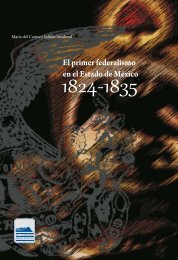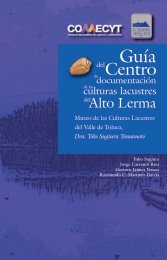Create successful ePaper yourself
Turn your PDF publications into a flip-book with our unique Google optimized e-Paper software.
KORPUS <strong>21</strong>, VOL. 4, NÚM. <strong>10</strong>, 2024, 67-78<br />
dation in 1754) to “death” (the excloistering in<br />
1863). 4 That story would include the rebellion, of<br />
course, but it would aim for a more expansive<br />
explanation of how the convent turned out the<br />
way it did, one that did not assume at the outset<br />
that the rebellion was the defining feature<br />
of the convent’s troubled history. In the end the<br />
book had six chapters, only two of which were<br />
squarely centered on the rebellion. 5<br />
Biography of a convent<br />
Thinking of a convent as the subject of a biography<br />
meant, inevitably, being open to granting<br />
an inanimate institution a degree of agency, independent<br />
of the agency of the individual actors<br />
that appear in the story. Much of the scholarship<br />
on “things” as agents had yet to be written at<br />
the time I was working on my book, but I was<br />
aware of Alfred Gell’s recent book arguing that<br />
point (Gell, 1998). 6 And indeed, my research was<br />
compatible with the idea that nonhuman features<br />
of a convent (its constitution, its buildings)<br />
actively shaped its history.<br />
La Purísima was constitutionally structured<br />
as a reformed, strict observance convent. This<br />
meant there would be no servants, no separate<br />
cells for the nuns to live in, no “niñas” (protégés/<br />
companions who were part of the nuns’ households),<br />
no individual kitchens (or as it was put,<br />
the nuns would eat “from a common pot”). The<br />
nuns would awaken in the middle of the night to<br />
sing the lesser hours of the Divine Office. Theirs<br />
would be a convent of descalzas (as were most<br />
new convents authorized after 1750, a response<br />
to the influence of an “enlightened” Catholicism<br />
that emphasized more stripped down and quiet<br />
religious practices). 7<br />
4 The convent “died” in that unlike the other convents in<br />
the archbishopric, the nuns made no attempt of which I am<br />
aware to live together or reconstitute their community for<br />
the next 45 years. But, as is detailed in the book, there was<br />
an ultimately-successful effort to recruit new nuns and revive<br />
the convent beginning in 1912.<br />
5 Though it is true that one other chapter largely revolved<br />
around the efforts made by abbesses, bishops, and vicars to<br />
ameliorate the conditions in the convent that had given rise<br />
to the rebellions.<br />
6 Later work includes “The Tribune Tower: Spolia as<br />
Despoliation.” (Wharton, 2011); Onto-Cartography: An<br />
Ontology of Machines and Media (Bryant, 2014).<br />
7 See also: Alone Before God: The Religious Origins of<br />
Modernity in Mexico (Voekel, 2002); For God and Liberty:<br />
Catholicism and Revolution in the Atlantic World (Voekel,<br />
2023); The Very Nature of God: Baroque Catholicism and<br />
Religious Reform in Bourbon Mexico City (Larkin, 20<strong>10</strong>).<br />
But La Purísima was also a Conceptionist<br />
convent. All the other Conceptionist convents in<br />
New Spain were unreformed. So while the Capuchins<br />
or the Carmelites or the Poor Clares had<br />
long-standing reputations as strict observance<br />
convents and/or austere convents, and any entrant<br />
into these convents knew what to expect,<br />
in the case of La Purísima there was a clash between<br />
the Conceptionists’ reputation as a relaxed<br />
order, and the reality of its constitutional<br />
provisions for poverty and strict observance.<br />
This misperception was a key factor in generating<br />
resistance on the part of one faction of nuns<br />
to the zealousness of the “obedient” faction.<br />
The divide along lines of observance created<br />
by the constitution of the convent was exacerbated<br />
by the unfortunate combination of nuns<br />
brought to San Miguel as founding nuns. The<br />
first abbess (whom we have already met) was<br />
utterly committed to the idea of building a reformed<br />
convent, after her experience in what she<br />
described as the shockingly relaxed convent of<br />
Regina Coeli in Mexico City. The second abbess,<br />
who took over after the bishop had to remove<br />
the first one because of her intransigence, was<br />
also in favor of reform, but she was weak and<br />
incompetent. The third founding nun, Phelipa de<br />
San Antonio, like the other two, had volunteered<br />
to go to San Miguel because she was unhappy<br />
at Regina Coeli. But her unhappiness there —the<br />
source of which she never detailed— clearly derived<br />
from different reasons. 8 She was never fully<br />
committed to the idea of a strict observance<br />
convent, and though she told the abbess that<br />
she wanted to join such a convent, it appears<br />
that she did so only to escape Regina Coeli.<br />
She began pushing back against the first abbess<br />
and then the second almost from the start.<br />
Thus none of the three was interested in bringing<br />
the culture of Regina Coeli to San Miguel;<br />
they were interested in leaving it behind. They<br />
would have to build a new convent culture from<br />
scratch. And with only three experienced nuns<br />
the chances that they would be able to build this<br />
new culture and stabilize the new convent were<br />
not great. All of the comparable convents in the<br />
bishopric had more founding nuns, and none of<br />
them was charged with putting into place a con-<br />
8 There was a fourth founding nun, but she returned to<br />
Mexico City, ostensibly, for health reasons, shortly after<br />
arriving in San Miguel. It is likely that she too chafed under<br />
the demands of the first abbess.<br />
69



![bicentenario_1[V2]](https://img.yumpu.com/68677971/1/167x260/bicentenario-1v2.jpg?quality=85)
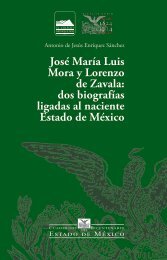
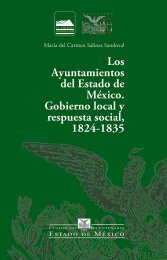

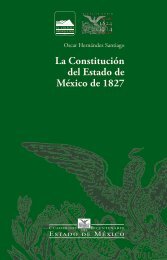
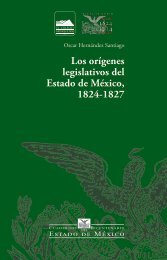
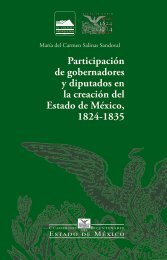
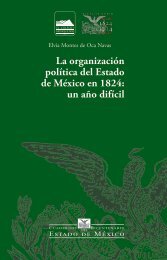
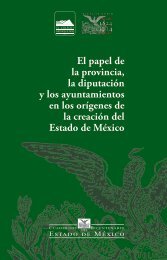
![El_primer_federalismoEM[final]_compressed (2)](https://img.yumpu.com/68483279/1/178x260/el-primer-federalismoemfinal-compressed-2.jpg?quality=85)
